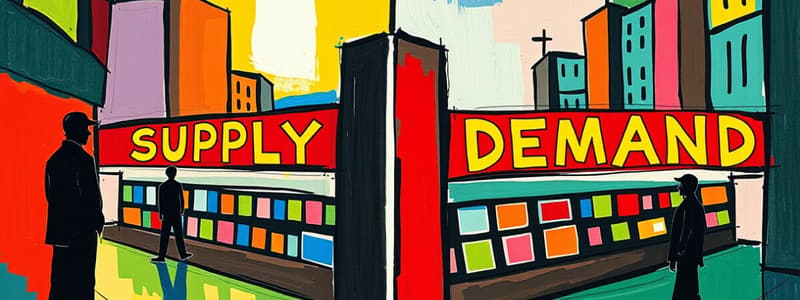Podcast
Questions and Answers
What is the primary purpose of tariffs in international trade?
What is the primary purpose of tariffs in international trade?
- To increase the quantity of goods exported.
- To protect domestic industries from foreign competition. (correct)
- To facilitate trade agreements between countries.
- To lower the price of imported goods.
Which of the following measures is NOT a tool of monetary policy?
Which of the following measures is NOT a tool of monetary policy?
- Trade Agreements (correct)
- Open Market Operations
- Interest Rates adjustments
- Reserve Requirements
What does nominal GDP measure?
What does nominal GDP measure?
- Total value of goods/services produced in previous years.
- Total value of goods/services excluding government expenditures.
- Total value of goods/services adjusted for inflation.
- Total value of goods/services produced within a country at current prices. (correct)
Expansionary monetary policy aims to achieve which of the following?
Expansionary monetary policy aims to achieve which of the following?
Which component is NOT part of the GDP calculation?
Which component is NOT part of the GDP calculation?
What happens to demand when the price of a good decreases?
What happens to demand when the price of a good decreases?
Which of the following is a characteristic of perfect competition?
Which of the following is a characteristic of perfect competition?
What is a primary characteristic of a monopoly?
What is a primary characteristic of a monopoly?
What type of fiscal policy is aimed at stimulating the economy during a recession?
What type of fiscal policy is aimed at stimulating the economy during a recession?
What does comparative advantage allow a country to achieve?
What does comparative advantage allow a country to achieve?
Which market structure is characterized by a few firms that dominate the market?
Which market structure is characterized by a few firms that dominate the market?
What is the main purpose of contractionary fiscal policy?
What is the main purpose of contractionary fiscal policy?
What does 'equilibrium' refer to in the context of supply and demand?
What does 'equilibrium' refer to in the context of supply and demand?
Flashcards
Supply
Supply
Quantity of goods/services producers offer at various prices.
Demand
Demand
Quantity of goods/services consumers buy at various prices.
Law of Demand
Law of Demand
Price decreases lead to increased demand.
Law of Supply
Law of Supply
Signup and view all the flashcards
Equilibrium
Equilibrium
Signup and view all the flashcards
Perfect Competition
Perfect Competition
Signup and view all the flashcards
Monopolistic Competition
Monopolistic Competition
Signup and view all the flashcards
Oligopoly
Oligopoly
Signup and view all the flashcards
Monopoly
Monopoly
Signup and view all the flashcards
Fiscal Policy
Fiscal Policy
Signup and view all the flashcards
Monetary Policy
Monetary Policy
Signup and view all the flashcards
Comparative Advantage
Comparative Advantage
Signup and view all the flashcards
GDP (Gross Domestic Product)
GDP (Gross Domestic Product)
Signup and view all the flashcards
Study Notes
Micro and Macro Economics Study Notes
Supply and Demand
- Supply: The quantity of a good or service that producers are willing to sell at various prices.
- Demand: The quantity of a good or service that consumers are willing to buy at various prices.
- Law of Demand: As the price of a good decreases, demand increases and vice versa.
- Law of Supply: As the price of a good increases, supply increases and vice versa.
- Equilibrium: The point where supply equals demand, determining market price.
- Shifts in Curves:
- Demand shift factors: consumer preferences, income, prices of related goods, expectations.
- Supply shift factors: production costs, technology, number of suppliers, expectations.
Market Structures
- Perfect Competition: Many firms, identical products, free entry/exit, price takers.
- Monopolistic Competition: Many firms, differentiated products, some price-setting power.
- Oligopoly: Few firms dominate the market, interdependent pricing, barriers to entry.
- Monopoly: Single firm, unique product, significant barriers to entry, price maker.
- Key Characteristics: Number of firms, type of products, barriers to entry.
Fiscal Policy
- Definition: Government's use of spending and taxation to influence the economy.
- Components:
- Government Spending: Investments in infrastructure, education, and services.
- Taxation: Changes in tax rates influence consumer spending and business investment.
- Objectives:
- Stimulate economic growth during recessions.
- Control inflation during economic booms.
- Types:
- Expansionary Fiscal Policy: Increased spending or tax cuts to boost economy.
- Contractionary Fiscal Policy: Decreased spending or tax increases to cool economy.
International Trade
- Benefits: Access to a larger market, economies of scale, diverse products.
- Comparative Advantage: Ability of a country to produce goods at a lower opportunity cost than another.
- Trade Barriers:
- Tariffs: Taxes on imports to protect domestic industries.
- Quotas: Limits on the quantity of goods imported.
- Balance of Trade: Difference between a country's exports and imports.
- Trade Agreements: Treaties that reduce trade barriers between countries.
Monetary Policy
- Definition: Central bank actions to control money supply and interest rates.
- Goals:
- Control inflation.
- Stabilize currency.
- Promote employment.
- Tools:
- Open Market Operations: Buying/selling government bonds to influence money supply.
- Interest Rates: Adjusting the discount rate to influence borrowing costs.
- Reserve Requirements: Changing the amount banks must hold in reserve.
- Types:
- Expansionary Monetary Policy: Lower interest rates to stimulate economy.
- Contractionary Monetary Policy: Increase interest rates to curb inflation.
GDP (Gross Domestic Product)
- Definition: Total value of all goods and services produced within a country in a specific time period.
- Components:
- Consumption: Spending by households on goods/services.
- Investment: Business spending on capital goods.
- Government Spending: Expenditures on goods/services by the government.
- Net Exports: Exports minus imports.
- Types:
- Nominal GDP: Measured at current prices, not adjusted for inflation.
- Real GDP: Adjusted for inflation, reflects true economic growth.
- Importance: Indicator of economic health, used for policy-making and comparison between economies.
Supply and Demand
- Supply: Represents the quantity of a good/service that producers are willing to offer at different price levels.
- Demand: Illustrates the quantity of a good/service consumers are ready to purchase at various prices.
- Law of Demand: Indicates that price decreases lead to an increase in demand, while price increases result in decreased demand.
- Law of Supply: Suggests that as prices rise, the quantity supplied also increases, and conversely, lower prices result in lower supply.
- Equilibrium: The state where the quantity supplied equals the quantity demanded, establishing the market price.
- Demand Shift Factors: Influenced by consumer preferences, income levels, prices of related goods, and future expectations.
- Supply Shift Factors: Affected by production costs, advancements in technology, the number of suppliers in the market, and expectations regarding the future.
Market Structures
- Perfect Competition: Features many firms offering identical products, characterized by free market entry and exit, leading to price-taking behavior.
- Monopolistic Competition: Consists of numerous firms selling differentiated products, allowing some degree of price-setting power.
- Oligopoly: Dominated by a few firms, where pricing decisions are interconnected and significant barriers to entry exist.
- Monopoly: Comprised of a single company providing a unique product, facing high barriers to entry and possessing price-setting capability.
- Key Characteristics of Market Structures: Includes the number of firms involved, product types offered, and presence of barriers to entry.
Fiscal Policy
- Definition: Involves government strategies utilizing spending and taxation to shape economic conditions.
- Government Spending: Encompasses investments in various sectors like infrastructure, education, and social services.
- Taxation Effects: Modifications in tax rates can significantly impact consumer spending habits and business investment decisions.
- Objectives of Fiscal Policy: Aims to stimulate economic growth during downturns and manage inflation during periods of expansion.
- Types of Fiscal Policy:
- Expansionary Fiscal Policy: Involves increased governmental spending or tax reductions to invigorate the economy.
- Contractionary Fiscal Policy: Entails reduced government spending or tax hikes to cool down an overheating economy.
International Trade
- Benefits of International Trade: Grants access to broader markets, leads to economies of scale, and introduces product variety.
- Comparative Advantage: A situation where a country can produce certain goods at a lower opportunity cost than others.
- Trade Barriers:
- Tariffs: Taxes levied on imports to safeguard domestic industries.
- Quotas: Restrictions on the volume of goods that can be imported.
- Balance of Trade: The differential between a nation's exports and imports, indicating trade status.
- Trade Agreements: Treaties that streamline trade between countries by reducing or eliminating trade barriers.
Monetary Policy
- Definition: Central bank efforts to regulate money supply and interest rates to manage economic performance.
- Goals of Monetary Policy: Focuses on controlling inflation, stabilizing currency value, and promoting employment levels.
- Monetary Policy Tools:
- Open Market Operations: Involves buying/selling government bonds to affect the money supply.
- Interest Rates: Manipulating the discount rate influences borrowing costs for banks and consumers.
- Reserve Requirements: Changing the mandated reserve levels for banks to control lending capacity.
- Monetary Policy Types:
- Expansionary Monetary Policy: Lowering interest rates to stimulate economic growth.
- Contractionary Monetary Policy: Raising interest rates to combat inflationary pressures.
GDP (Gross Domestic Product)
- Definition: The aggregate value of all goods and services produced in a country over a specified timeframe.
- Components of GDP:
- Consumption: Expenditures by households on various goods and services.
- Investment: Business investment in durable capital goods.
- Government Spending: Government expenditures on goods and services.
- Net Exports: The balance of exports minus imports.
- GDP Types:
- Nominal GDP: Measured using current market prices, without adjusting for inflation impacts.
- Real GDP: Adjusted for inflation, providing a more accurate representation of economic growth.
- Importance of GDP: Serves as a key indicator of economic health, guiding policy decisions and facilitating comparisons between different economies.
Studying That Suits You
Use AI to generate personalized quizzes and flashcards to suit your learning preferences.



